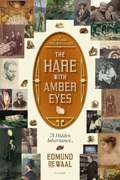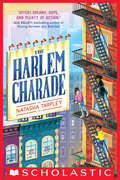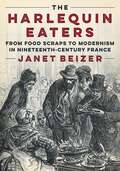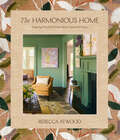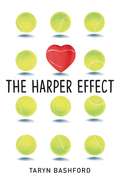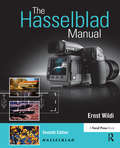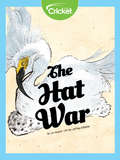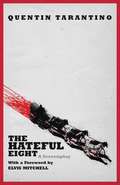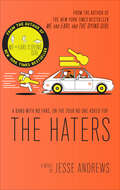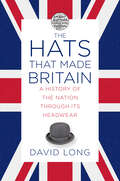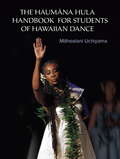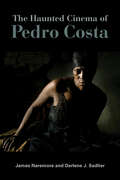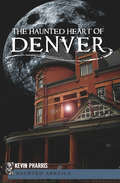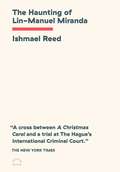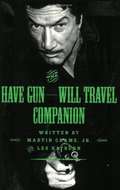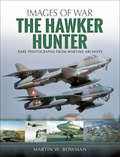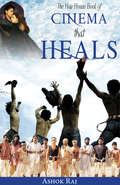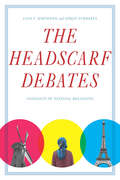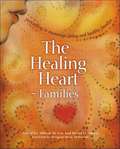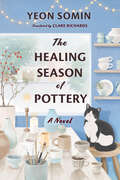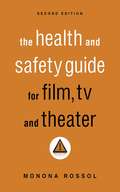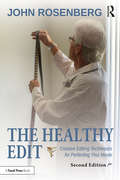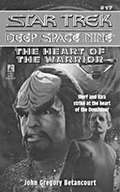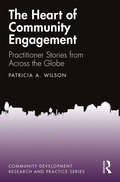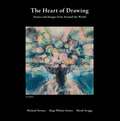- Table View
- List View
The Hare With Amber Eyes: A Hidden Inheritance
by Edmund De WaalEdmund de Waal is a world-famous ceramicist. Having spent thirty years making beautiful pots―which are then sold, collected, and handed on―he has a particular sense of the secret lives of objects. When he inherited a collection of 264 tiny Japanese wood and ivory carvings, called netsuke, he wanted to know who had touched and held them, and how the collection had managed to survive. <p><p> And so begins this extraordinarily moving memoir and detective story as de Waal discovers both the story of the netsuke and of his family, the Ephrussis, over five generations. A nineteenth-century banking dynasty in Paris and Vienna, the Ephrussis were as rich and respected as the Rothchilds. Yet by the end of the World War II, when the netsuke were hidden from the Nazis in Vienna, this collection of very small carvings was all that remained of their vast empire.
The Harlem Charade (Penworthy Picks Middle School Ser.)
by Natasha TarpleyFans of Chasing Vermeer will love this clever mystery about art, artifice, and the power of community.WATCHER. SHADOW. FUGITIVE.Harlem is home to all kinds of kids. Jin sees life passing her by from the window of her family's bodega. Alex wants to help the needy one shelter at a time, but can't tell anyone who she really is. Elvin's living on Harlem's cold, lonely streets, surviving on his own after his grandfather was mysteriously attacked.When these three strangers join forces to find out what happened to Elvin's grandfather, their digging leads them to an enigmatic artist whose missing masterpieces are worth a fortune-one that might save the neighborhood from development by an ambitious politician who wants to turn it into Harlem World, a ludicrous historic theme park. But if they don't find the paintings soon, nothing in their beloved neighborhood will ever be the same . . .In this remarkable tale of daring and danger, debut novelist Natasha Tarpley explores the way a community defines itself, the power of art to show truth, and what it really means to be home.
The Harlequin Eaters: From Food Scraps to Modernism in Nineteenth-Century France
by Janet BeizerHow representations of the preparation, sale, and consumption of leftovers in nineteenth-century urban France link socioeconomic and aesthetic history The concept of the &“harlequin&” refers to the practice of reassembling dinner scraps cleared from the plates of the wealthy to sell, replated, to the poor in nineteenth-century Paris. In The Harlequin Eaters, Janet Beizer investigates how the alimentary harlequin evolved in the nineteenth and early twentieth centuries from the earlier, similarly patchworked Commedia dell&’arte Harlequin character and can be used to rethink the entangled place of class, race, and food in the longer history of modernism. By superimposing figurations of the edible harlequin taken from a broad array of popular and canonical novels, newspaper articles, postcard photographs, and lithographs, Beizer shows that what is at stake in nineteenth-century discourses surrounding this mixed meal are representations not only of food but also of the marginalized people—the &“harlequin eaters&”—who consume it at this time when a global society is emerging. She reveals the imbrication of kitchen narratives and intellectual–aesthetic practices of thought and art, presenting a way to integrate socioeconomic history with the history of literature and the visual arts. The Harlequin Eaters also offers fascinating background to today&’s problems of food inequity as it unpacks stories of the for-profit recycling of excess food across class and race divisions.
The Harmonious Home: Designing Peaceful, Personal Spaces Inspired by Nature
by Rebecca AtwoodA holistic approach to creating a home using the colors, patterns, and textures found in the natural world, from the author of Living with Color and Living with Pattern.Hailed by Vogue for her "approachable patterns and textiles" Rebecca Atwood shares a new method for styling your interiors, one guided by nature: specifically landscapes that capture your imagination. As an artist, she has found that the details of a landscape helps make design accessible, and when decorating a home, it can even direct the decisions you make. Think of a place outside that contains a mood you want to bring into your home, such as the beach or a garden you saw on your travels. Identify the colors in its landscape and you can choose a room&’s paint colors. Pick out its textures and you can decide what materials—rugs, wallpaper, upholstery fabric—to bring into the room. The Harmonious Home walks you through six different landscapes—Dunes, Ocean, Field, Forest, Garden, and City—and shows you how to pull together color and pattern combinations you might not have imagined on your own that evoke the feeling of the place without looking overly thematic.Throughout, you&’ll find gorgeous photographs of interiors around the country and expert advice from celebrated interior designers for selecting lighting, a floor plan, window treatments, and more. With endless inspiration for building a room around a mood, The Harmonious Home takes you from fabric and paint swatches to a harmonious design that feels like home.
The Harper Effect
by Taryn BashfordA sizzling coming of age story set in the world of professional tennis about a girl who learns to win from a boy who has lost everything. Sixteen-year-old Harper was once a rising star on the tennis court—until her coach dropped her for being “mentally weak.” Without tennis, who is she? Her confidence at an all-time low, she secretly turns to her childhood friend, next-door neighbor Jacob—who also happens to be her sister’s very recent ex-boyfriend. If her sister finds out, it will mean a family war. But when Harper is taken on by a new coach who wants her to train with Colt, a cold, defensive, brooding young tennis phenom, she hits the court all the harder, if only to prove to Colt she has it in her to be a champion. As the two learn to become a team, Harper gets glimpses of the vulnerable boy beneath the surface, the boy who was deeply scarred by his family’s dark and scandalous past. The boy she could easily find herself falling for. As she walks a fine line between Colt’s secrets, her forbidden love, and a game that demands nothing but the best, Harper must choose between her past and her future and between two boys who send her head spinning. Turns out, the biggest battle she needs to win, is the one against herself.
The Hasselblad Manual: A Comprehensive Guide To The System
by Ernst WildiDiscover the great advantages and benefits of working in the medium film format or with the large digital sensor units in Hasselblad digital cameras and digital backs. Presented in an easily accessible format, this book shows the working and manipulation of the various cameras. Detailed illustrations dissect the equipment and provide insight into the ways in which these superb cameras and lenses are best utilized to create professional quality images. This edition of the Manual will bring you up to date with the latest features available within the popular Hasselblad camera systems emphasizing that camera and lens are the most important tools for creating exciting images whether you work digitally or with film. The complete Hasselblad camera system is discussed by renowned author and Hasselblad insider, Ernst Wildi, who provides a solid foundation of both traditional photography and digital capture techniques. Inside you'll also find inspiring photographs from well-known photographers, illustrating a variety of photographic techniques using a Hasselblad camera.
The Hat War
by Liz HuyckHave you ever seen a feather in a hat? A long time ago, they were very fashionable. Some people would even put whole birds on their hats! To get the feathers, though, the birds had to be hunted. Learn about the women who fought to change laws in the name of conservation!
The Hateful Eight
by Quentin TarantinoAcademy Award-winning screenwriter Quentin Tarantino returns with his most infamous, most brilliant, most masterful screenplay yet... At the end of the Civil War, a stagecoach hurtles through the wintry Wyoming landscape. Bounty hunter John Ruth and his fugitive captive Daisy Domergue race toward the town of Red Rock, where Ruth will bring Domergue to justice. Along the road, they encounter Major Marquis Warren, a former Union soldier turned infamous bounty hunter; and Chris Mannix, a renegade who claims to be the town's new sheriff. Lost in a blizzard, Ruth, Domergue, Warren, and Mannix seek refuge at Minnie's Haberdashery, a stagecoach stopover. When they arrive, they are greeted by four unfamiliar faces: Bob, who takes care of Minnie's in the owner's absence; Oswaldo Mobray, the hangman of Red Rock; cow-puncher Joe Gage; and Confederate general Sanford Smithers. As the storm overtakes the mountainside, our eight travelers come to learn they may not make it to Red Rock after all ... THE HATEFUL EIGHT is a Tarantino master class in tension-filled atmosphere, singular characters, and razor-sharp dialogue.
The Haters: A Novel
by Jesse AndrewsFrom Jesse Andrews, author of the New York Times bestselling Me and Earl and the Dying Girl and screenwriter of the Sundance award–winning motion picture of the same name, comes a groundbreaking young adult novel about music, love, friendship, and freedom as three young musicians follow a quest to escape the law long enough to play the amazing show they hope (but also doubt) they have in them. For Wes and his best friend, Corey, jazz camp turns out to be lame. It’s pretty much all dudes talking in Jazz Voice. But then they jam with Ash, a charismatic girl with an unusual sound, and the three just click. It’s three and a half hours of pure musical magic, and Ash makes a decision: They need to hit the road. Because the road, not summer camp, is where bands get good. Before Wes and Corey know it, they’re in Ash’s SUV heading south, and The Haters Summer of Hate Tour has begun. In his second novel, Andrews again brings his brilliant and distinctive voice to YA, in the perfect book for music lovers, fans of The Commitments (author Roddy Doyle raves "The Haters is terrific. It is shocking and funny, unsettling and charming."), and High Fidelity, or anyone who has ever loved—and hated—a song or a band. This witty, funny coming-of-age novel is contemporary fiction at its best.
The Hats that Made Britain: A History of the Nation Through its Headwear
by David LongMany of the world’s most famous hats have their origins in Britain; in the Middle Ages there were civil and religious laws requiring hats to be worn and in Victorian Britain a person would no more leave home without a hat than a pair of trousers. It is no surprise that London’s oldest surviving shop, Lock and Co., is a hatter. From practical everyday caps and bonnets to military headwear, top hats, and even the coronation crown, hats of all sorts have passed through its doors and continue to do so after more than 300 years. In this fascinating new book David Long reveals how much of Britain’s social history can be understood through its headwear, and in exploring the ways in which a hat speaks volumes about its wearer’s rank and status he tells the stories of the people beneath some of the most famous hats of history.
The Haumana Hula Handbook for Students of Hawaiian Dance: A Manual for the Student of Hawaiian Dance
by Mahealani Uchiyama Naomi Leina'Ala KalamaA great resource for students of traditional Hawaiian dance, this beautiful handbook filled with archival photographs covers the origins, language, etiquette, ceremonies, and the spiritual culture of Hula. Hula, the indigenous dance of Hawai'i, preserves significant aspects of Native Hawaiian culture with strong ties to health and spirituality. Kumu Hula, persons who are culturally recognized Hula experts and educators, maintain and share this cultural tradition, conveying Hawaiian history and spiritual beliefs in this unique form of cultural and creative expression, comprising specific controlled rhythmic movements that enhance the meaning and poetry of the accompanying songs.Emphasizing the importance of cultural literacy, the Handbook begins with an overview of the origins of Hula, its history in Hawai'i, and the primacy of the spiritual focus of the dance. The book goes on to introduce halau etiquette and practices, and explains the format of a traditional Hula presentation, together with the genres of Hula and the regalia worn by the dancers. Practical components include sections on Hawaiian language and chant and a glossary of Hula commands and footwork.Author Mahealani Uchiyama trained in Hawaii in the Hula lineage of Joseph Kamoha'i Kaha'ulelio and is currently the Kumu Hula at the Halau Ku Ua Tuahine in Berkeley, California. As the founder and artistic director of the Center for International Dance and board member of Dance Arts West, the producers of San Francisco's annual Ethnic Dance Festival, Uchiyama's approach to Hula is deeply holistic and reflects her background in indigenous wisdom traditions and cultural exchange and interaction.From the Trade Paperback edition.
The Haunted Cinema of Pedro Costa
by James Naremore Darlene J. SadlierFor over three decades, Portuguese director Pedro Costa has been widely admired for his unusual and innovative body of work, which has earned accolades and wide acclaim. The Haunted Cinema of Pedro Costa is the most complete treatment of his work, exploring Costa's feature films from Blood to Vitalina Varela, and from the documentaries to the short films, museum exhibitions, and the forthcoming Daughters of Fire. Authors James Naremore and Darlene J. Sadlier situate Costa within the history and culture of Portugal, at the same time providing insightful close readings and stylistic analysis of the films. Their work explores the unusual features of his artistry and illuminates his unique contribution to cinema. An accessible portrait of an important artist, The Haunted Cinema of Pedro Costa is an indispensable companion for scholars, students, and cinephiles everywhere.
The Haunted Heart of Denver (Haunted America)
by Kevin PharrisThere is no shortage of ghouls and goblins in Colorado&’s Mile High City. Just ask reluctant ghost hunter Kevin Pharris, author of Riding Denver&’s Rails. The Gates of Hell are rumored to lie below a hotel near Denver&’s capitol building, and there are tales of restless spirits of those buried in Cheesman Park. Above the subterranean darkness, the city streets are haunted by the murderous poltergeist of the Capitol Hill Thug. Even the stately mansions of Millionaires&’ Row hide their own secrets, a sad Victorian lady begs for help before vanishing in the Sheedy Mansion, and an eerie face appears on the façade of the Cresswell House. Join tour guide and reluctant ghost hunter Kevin Pharris as he takes a chilling journey through The Haunted Heart of Denver. Includes photos!
The Haunting of Lin-Manuel Miranda
by Ishmael Reed&“That&’s a lot of horse hockey, Hamilton.&” Described by the New York Times as &“classic activist theater&” and &“a cross between &‘A Christmas Carol&’ and a trial at The Hague&’s International Criminal Court.&” "In this, his latest work, the protean Ishmael Reed--the legendary artist and prolific writer--continues to burnish his already sterling reputation by dismantling the 'Creation Myth' of the founding of the U.S., as represented in the incredibly profitable play and musical, Hamilton. Reed, a verbal acrobat of global renown, demonstrates here why he is widely considered to be the leading intellectual in the U.S. today." -Gerald Horne, author of The Counter-Revolution of 1776: Slave Resistance and the Origins of the USA This powerful play, originally produced at the Nuyorican Poets Café, comprehensively dismantles the phenomenon of Lin-Manuel Miranda and Hamilton. Reed uses the musical&’s crimes against history to insist on a radical, cleareyed way of looking at our past and our selves. Both durable and timely, this goes beyond mere corrective – it is a meticulously researched rebuttal, an absorbing drama, and brilliant rallying cry for justice. The perfect tie-in to both the success of and backlash to Hamilton, it is the major voice in contrast to the recent movie. It captures both the earnest engagement that fans of the musical desire, as well as the exhausted disbelief of those who can&’t stand it. Teachers, students and fans of drama, literature, and history will find much to love. It is written by one of America&’s most respected and original writers, who is eagerly promoting it, and who is long overdue for a renaissance.
The Have Gun, Will Travel Companion
by Les Rayburn Martin GramsThis program ran for six seasons--225 episodes--and this book tells all about its planning, its presenting, its struggles, and its people. If just reading the title makes you start humming the theme song, you won't want to miss a word!
The Hawker Hunter: Rare Photographs from Wartime Archives (Images of War)
by Martin W. BowmanA “well-done” pictorial history of the legendary fighter plane “that both enthusiasts and modelers alike will enjoy”(ModelingMadness).If ever there was a real pilot’s airplane it was the Hunter: an outstanding multipurpose aircraft which excelled in the roles of interceptor fighter, ground attack, reconnaissance, research vehicle, and two-seater trainer, not forgetting its dramatic formation aerobatic performances.For decades, pilots have enthused about the Hunter, extolling the virtues of its smooth, aerodynamic lines, 4 x 30mm cannon, the Rolls-Royce Avon engine, and its outstandingly honest handling characteristics combined with a lively performance. It saw operational deployment in Europe with Fighter Command and 2nd TAF, in Cyprus, the Middle East, and the Far East, operating in the ground-attack role against rebels in Aden and Malaysia respectively. The Hunter was a classic thoroughbred of its time, from the stables of one of the finest fighter manufacturers in the world and, for fifty years, its adaptability was rarely challenged.Although the last example was retired in July 2001, the Hunter legend undoubtedly lives on, with 114 potentially air-worthy airframes located in fourteen countries around the world. Here, the legendary tale of the Hunter is told in words and images.
The Hay House Book of Cinema that Heals
by Ashok RajA unique volume that highlights – tellingly and poignantly – how the impact of the Hindi film over the decades has played a significant role in trying to bring together people belonging to different faiths and different strata of society. Covering a vast time span from the silent era to the present, this work focuses on Hindi cinema’s attempts at promoting harmony and trust among various religions, communities and ethnic groups, while performing its basic function of entertaining the viewers. It identifies appropriate situations and characters in select films – such as Padosi (1941), Hum Ek Hain (1946), Mughal-e-Azam (1960), Dharamputra (1961), Amar Akbar Anthony (1977), Ghulam-e-Musthafa (1997), Lagaan (2001) and Veer-Zara (2004) – and describes how positive messages have been articulated through them. It also examines the response of the film makers to the changes that have been taking place over the years in society vis-à-vis the communal milieu in the country and their contribution towards making a cinema that heals. Ever since its inception a century ago, Indian cinema, far more than other popular cultural medium, has consistently taken up highly appealing and socially relevant interpretations of popular religious beliefs and customs. It has often attempted to ensure that the audiences identified themselves with the characters as they enacted their roles on screen. This cinema, though dominated by love stories and romantic escapism, has, occasionally, sent out a powerful message against age-old religious orthodoxy and outdated traditions by emphasizing that such factors have caused tremendous social tensions and suffering. In a very significant way, Indian cinema has tried to systematically break down religious and other barriers (say, ethnic, language, caste and class) and has endeavoured to engender an egalitarian society despite numerous obstacles. Here is a work that all readers, film buffs or not, will find stimulating, engrossing and informative.
The Headscarf Debates: Conflicts of National Belonging
by Anna C. Korteweg Gökçe YurdakulThe headscarf is an increasingly contentious symbol in countries across the world. Those who don the headscarf in Germany are referred to as "integration-refusers." In Turkey, support by and for headscarf-wearing women allowed a religious party to gain political power in a strictly secular state. A niqab-wearing Muslim woman was denied French citizenship for not conforming to national values. And in the Netherlands, Muslim women responded to the hatred of popular ultra-right politicians with public appeals that mixed headscarves with in-your-face humor. In a surprising way, the headscarf—a garment that conceals—has also come to reveal the changing nature of what it means to belong to a particular nation. All countries promote national narratives that turn historical diversities into imagined commonalities, appealing to shared language, religion, history, or political practice. The Headscarf Debates explores how the headscarf has become a symbol used to reaffirm or transform these stories of belonging. Anna Korteweg and Gökçe Yurdakul focus on France, Germany, and the Netherlands—countries with significant Muslim-immigrant populations—and Turkey, a secular Muslim state with a persistent legacy of cultural ambivalence. The authors discuss recent cultural and political events and the debates they engender, enlivening the issues with interviews with social activists, and recreating the fervor which erupts near the core of each national identity when threats are perceived and changes are proposed. The Headscarf Debates pays unique attention to how Muslim women speak for themselves, how their actions and statements reverberate throughout national debates. Ultimately, The Headscarf Debates brilliantly illuminates how belonging and nationhood is imagined and reimagined in an increasingly global world.
The Healing Heart—Families: Storytelling to Encourage Caring and Healthy Families
by Allison M. Cox and David H. AlbertStories and narratives aimed at helping families work through an array of subjects like health, illness, grief, adoption, sexual identity, and school.The Healing Heart provides powerful examples of the use of stories and storytelling in encouraging resiliency, empathy, respect, and healing. These engaging books contain stories, and narratives about the use of the stories in activities with different populations (children, teens, those with disabilities, seniors, inmates, etc.) or which address specific social or community problems (addictions, poverty, violence, racism, environmental degradation, homelessness, abuse).The books are a collective effort containing the expertise of more than 60 storytellers and health professionals who illustrate the power of story in moving others to commitment and action, in building self-esteem and mutual respect.The Healing Heart ~ Families focuses on families, dealing specifically with healing through story, health promotion, disease prevention, early childhood intervention, children with medical problems, adopting families, schools, sexual identities, grief, and spiritual healing. The Healing Heart ~ Communities focuses on community-building, with sections on youth, violence prevention, poverty, domestic violence, substance abuse and addiction, racism, elders, culture, environmental protection, homelessness, and community development.Praise for The Healing Heart ~ Families“Both children and adults, sick or well, need the embrace of soulful storytelling. They need to witness and be witnessed, for it is in this state that healing occurs . . . . If newscasters were to read aloud each night to their listeners for 1,001 nights one of the stories from this treasury, we would all be healed and lose our fear, recapturing real security in our homeland.” —N. Michael Murphy, MD, author of The Wisdom of Dying“An extraordinary work . . . . Hit the bulls eye by providing both process and practice. Thought provoking and insightful theory is intertwined with appropriate stories for direct application. It makes clear that story can be a powerful catalyst for change, giving eloquent voice to what many of us have known for some time but have been unable to express. What a gift for those who work with families!” —Elizabeth Ellis, co-author of Inviting the Wolf In: Thinking about Difficult Stories
The Healing Season of Pottery
by Yeon SominSet for international release this fall, this cozy Korean bestseller invites readers into a warm, sunlit pottery studio where a burned-out young TV broadcast writer begins to heal, working the clay, piece by piece, season by season. After breaking down at the office and abruptly quitting her job, thirty-year-old Jungmin holes up in her apartment, speaking to no one for days on end. When she finally emerges, she stumbles upon a pottery studio in her neighborhood and is invited in by the mysterious workshop teacher. The smell of clay, the light filtering through the plant filled windows, the friendly cat, and the incredible coffee the students drink awaken her senses and make her feel alive and inspired for the first time in months. As the seasons change, Jungmin slowly returns to herself and builds a new community with the other members of the studio, who are all working through their own pasts at the pottery wheel. When the holidays approach and snow piles up on the studio windowsill, Jungmin realizes how much she has changed—with her hands busy and her mind clear, she may be ready to face the memories she&’s been running from and open her heart. For fans of What You Are Looking For Is in the Library and Welcome to the Hyunam-dong Bookshop, Yeon&’s charming English-language debut is a testament to the joy of slowing down in a fast-paced world, and an homage to the art of ceramics and the power of friendship. Readers won&’t want to leave the enchanting world of The Healing Season of Pottery after the final page.
The Health & Safety Guide for Film, TV & Theater, Second Edition
by Monona RossolThis second edition has been expanded and updated to address new hazards, unique health and safety problems, and particular regulations that threaten anyone working in the entertainment industries today. Artists' advocate Monona Rossol exposes the hazards of theatrical paints, theatrical makeup, pigments, dyes, plastics, solvents, woodworking, welding, asbestos, fog, and offers practical solutions to these dangers. No one working in the performing arts can afford to skip this handbook packed with life-or-death health and safety information.
The Healthy Edit: Creative Editing Techniques for Perfecting Your Movie (2nd Edition)
by John RosenbergThis updated and revised new edition of The Healthy Edit provides aspiring and working editors with creative editing strategies they can employ to enhance a film, while also overcoming common production problems. With decades of experience editing and film doctoring Hollywood features, author John Rosenberg reveals both the aesthetic and technical aspects of the editor’s art, demonstrating tricks and techniques for nursing an ailing project back to health or enhancing a well one. Whether it's a bad performance from an actor, a hole in the story or script, a continuity or pacing issue, or a poorly-composed shot, every film or show we watch encounters challenges during production—and fixing these issues becomes the job of the editor. Utilizing an approach comparing film editing to medicine, working editor and professor John Rosenberg offers a software-agnostic guide to best editing practices, offering solutions to everything from story and script inconsistencies to genre-specific structural issues. Accessibly written and brought fully up-to-date to embrace the predominance of file-based digital production, this second edition offers new insights into ultra-high-resolution footage, transitions, visual effects, collaboration, sound and music editing, as well as highlighting historic advances in the art form.
The Heart Of The Warrior (Star Trek )
by John Gregory BetancourtWhile a crucial peace conference fills Deep Space NineTMwith rumors of intrigue and conspiracy, Major Kira and Lt. Commander Worf embark on a dangerous undercover mission deep into the heart of the Gamma Quadrant. Their mission: to find the secret of the addictive substance that the Changelings use to control their Jem'Hadar warriors. But how long can Worf and Kira remain undetected in the midst of the Dominion? Odo may be their only hope; but to save them, he'll have to stand against his own people.
The Heart of Community Engagement: Practitioner Stories from Across the Globe (Community Development Research and Practice Series)
by Patricia A. WilsonDrawing on first-hand accounts of action research in the Americas, Africa, and Asia, The Heart of Community Engagement illustrates the transformative learning journeys of exemplary catalysts for community-based change. Practitioners’ stories of community engagement for social justice in the Global South elucidate the moments of insight and transformation that deepened their practice: how to deal with uncertainty, recognize their own blind spots, become aware of what is emergent and possible in the moment, and weave an inclusive bond of love, respect, and purpose. Each successive narrative adds a deeper level of understanding of the inner practice of community engagement. The stories illuminate the reflective, or inner, practice of the outside change agent, whether a planner, designer, participatory action researcher, or community development practitioner. From a shantytown in South Africa, to a rural community in India, or an informal settlement in peri-urban Mexico, the stories focus attention on the greatest leverage point for change that we, as engaged practitioners, have: our own self-awareness. By the end of the book, the practitioners are not only aware of their own conditioned beliefs and assumptions, but have opened their minds and hearts to the complex and dynamic patterns of emergent change that is possible. This book serves as a much-needed reader of practice stories to help instructors and students find the words, concepts, and examples to talk about their own subjective experience of community engagement practice. The book applies some of the leading-edge concepts from organizational development and leadership studies to the fields of planning, design, and community engagement practice. Key concepts include the deep dive of sensing the social field, seeing the whole, and presencing the emergent future. The book also provides a creative bridge between participatory action research and design thinking: user-based design, rapid prototyping, and learning from doing.
The Heart of Drawing: Stories and Images from Around the World
by Michael J. Strauss Mags Phelan StonesIn this unique new book, The Heart of Drawing, 59 artists from 22 countries exhibit their art and talk about their process of creation to inspire readers and help them find inspiration for their own creative efforts. The book is about what happens
